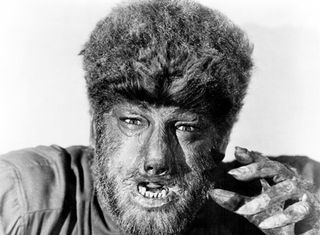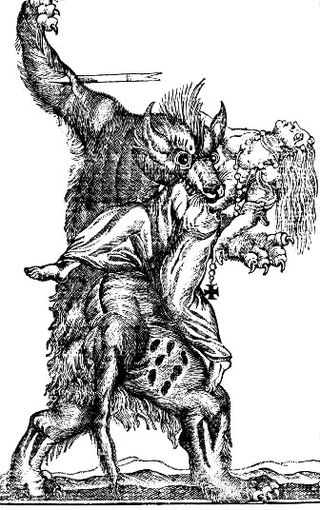Werewolves: Lore, Legend & Lycanthropy
Werewolves (literally "man-wolves") are shape-shifting creatures with unusual speed, strength, reflexes, and senses. They can be found in countless books, films, and television shows, from the horror classic, "The Wolf Man," to the "Twilight" and "Underworld" series. Though werewolves often play second fiddle to vampires and zombies in terms of pop culture man-monsters, they have a long and rich history.

Creating werewolves
Traditionally, there were several ways that a person could become a werewolf. In her book "Giants, Monsters, and Dragons," folklorist Carol Rose notes that "In ancient Greece it was believed that a person could be transformed by eating the meat of a wolf that had been mixed with that of a human and that the condition was irreversible." Centuries later other methods were said to create werewolves, including "being cursed, or by being conceived under a new moon, or by having eaten certain herbs, or by sleeping under the full moon on Friday, or by drinking water that has been touched by a wolf." It was also widely believed that werewolves could dress in a special, protective wolf skin, though they had to remove it at daybreak and hide it. If their magical pelt was found and taken from the werewolf-in-human-form, he or she could be killed.
A similar theme appears in the Scottish and Irish folklore of the selkies — creatures who spend their lives in the cold ocean as seals, but can change into human form by shedding their pelts. If they do so, they must hide their pelts for if they are found they can't change back into seals and must live on land with the fishermen who possess their skins.
Though the full moon was originally only one of many possible causes of lycanthropy, it was the one that stuck in the public's mind. Today, many people still associate the moon with werewolves and madness. Some who work in police and emergency medical services have anecdotally claimed that full moon nights are busier, crazier, and more dangerous than other nights. This perception may be rooted more in psychology and imagination than reality: carefully controlled studies have not found good evidence supporting this idea. Furthermore, there is no known mechanism by which the moon would somehow influence a person's mind to make him or her more dangerous — except of course for their own imaginations and expectations.
'Real' werewolves
Today, werewolves are known to be mythical creatures found in fiction instead of lurking in the dark woods, but that was not always the case. Not so long ago, belief in werewolves was common. Overall, there was little difference between the killings and activities of wolves and werewolves: both would hunt at night, attacking sheep or livestock, and sometimes humans. The main difference was, of course, that the werewolf changed into human form at some point.
There are several medical conditions that can mimic the appearance of a werewolf and may have contributed to early belief in the literal existence of the creatures. One is hypertrichosis, which creates unusually long hair on the face and body; a second condition, porphyria, is characterized by extreme sensitivity to light (thus encouraging its victims to only go out at night), seizures, anxiety, and other symptoms. Neither of these rare conditions turns anyone into a werewolf, of course, but centuries ago when belief in witches, vampires, and magic was common it didn't take much to spawn werewolf stories.
Clinical lycanthropy is a recognized medical condition in which a person believes himself or herself to be an animal, and indeedthere are rare cases where people have claimed to be werewolves. For example in 1589, a German man named Peter Stubbe claimed to own a belt of wolfskin that allowed him to change into a wolf: His body would bend into a lupine form; his teeth would multiply in his mouth; and he craved human blood.
Stubbe claimed to have killed at least a dozen people over 25 years — though his confession was made under difficult circumstances: After prolonged torture (including chunks of his flesh being ripped out with heated pinchers, and his limbs being crushed with stones) he was decapitated on Halloween 1589, and his headless body burned at the stake. There was no real evidence of his crimes other than his confession, and it seems likely that Stubbe was mentally ill and delusional.
Stubbe was far from alone. In the Middle Ages werewolves were thought to mostly be created by witches, and the two became closely associated. Just as tens of thousands of accused witches were put to death (usually in gruesome and sadistic ways), tens of thousands of accused werewolves were similarly dispatched.

Because lycanthropy was seen as a curse, werewolves were often thought of as victims as much as villains. The transformation from man to wolf was said to be tortuous (recall such scenes in the film "An American Werewolf in London"), and many sought cures for real and imagined symptoms. "Traditionally, there are three principal ways in which a werewolf can be scourged of his demons," writes Ian Woodward in "The Werewolf Delusion." "He may be cured medicinally and surgically; he may be exorcised; and, the most drastic, he may be shot with a special bullet" — typically a silver bullet. When the medicinal and surgical cures were attempted, they involved lots of bloodletting, vomiting, and vinegar drinking. In fact, Woodward notes, "So severe, so brutal, were the cures advocated by early medical practitioners that, not surprisingly, a great many werewolfic patients died by the hands of those who promised them salvation." [Countdown: Medieval Torture's 10 Biggest Myths]
While werewolves are the best-known shape-shifters they are not the only were-animals said to exist around the world. Others include were-foxes, were-dogs, were-tigers, were-snakes, were-hares, were-bears and even were-crocodiles. Of course, wolves are more threatening than dogs and foxes; there's a reason why most werewolf films are scary and "Wallace & Gromit: The Curse of the Were-Rabbit" was a comedy. Like vampires, werewolves have been around for millennia, and nothing short of a silver bullet is likely to stop it from being around millennia more.
Benjamin Radford is deputy editor of "Skeptical Inquirer" science magazine and author of six books, including "Tracking the Chupacabra: The Vampire Beast in Fact, Fiction, and Folklore." His website is www.BenjaminRadford.com.
Related:
Sign up for the Live Science daily newsletter now
Get the world’s most fascinating discoveries delivered straight to your inbox.

